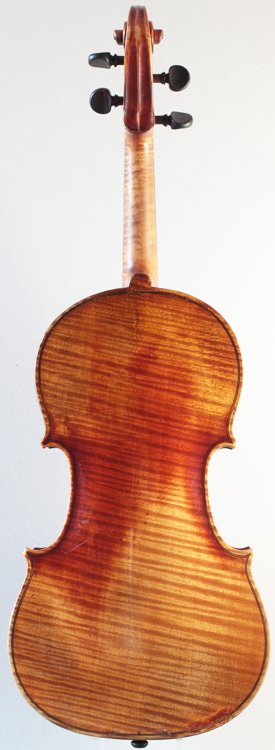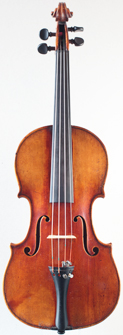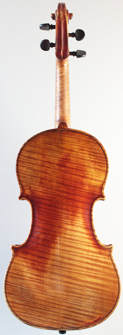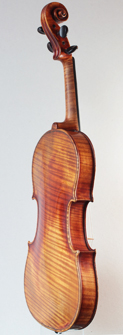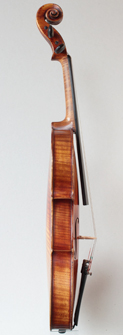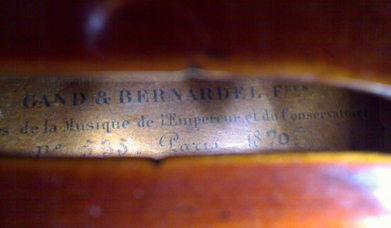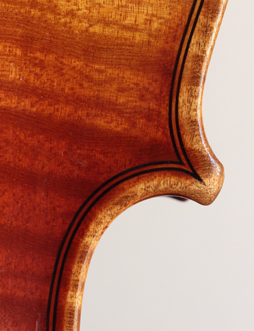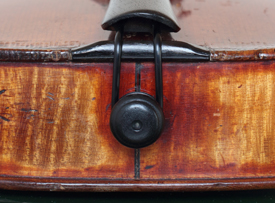Violin by Gand & Bernardel Frères, Paris, France, 1870
Made for Victor de Rivals
|
|
|
| |||||||||||||||
Description — Naturally Antiqued
This fine work of 1870 displays the classic
Lupot-Gand-Bernardel pattern, flat arching,
charismatic soundholes, and aged-burgundy varnish.
Furthermore, it has the typical back pins, bell-shaped button, and subtle purfling
corners of Gand & Bernardel Frères' first period, from 1866 to about 1870.
I find this violin's tonewood particularly pleasing,
especially the one-piece back with its slanted tiger stripes that overflow
around the ribs on both sides.
Did Victor de Rivals himself select this gorgeous maple? Possibly.
If you like antiqued instruments, this one is the real deal.
Not much is left of the original varnish, worn off through extensive playing.
Though I kind of like seeing the barewood patches — Looks like a wild animal.
History — Victor de Rivals (–Mazères)
According to
the Gand & Bernardel archives, violin number 535 was "tabled" on May 6, 1870 and reserved
for Mr. de Rivals, who bought it for 240 francs.
Victor de Rivals was a violinist at the
Société des Concerts du Conservatoire in Paris
(one of the first professional symphony orchestras).
He had played in its first-violin section from the founding year, 1828, to his retirement in 1864.
He also had been a client of the famed Paris violin shop since 1828,
when it belonged to Charles-François Gand, the father.
It seems he finally decided, after retiring, to commission a violin from
the Gand family.
Could our Victor de Rivals be the Mr. de Rivals-Mazères whose name is attached to
the Stradivari violin "Tua, Marie Soldat, Rivals-Mazères de Toulouse" of 1708?
The Cozio
Archive tells us this Stradivari belonged to Mr. de Rivals Mazere in 1880. The Gand & Bernardel
books tell us this same Stradivari was sold by Mr. de Rivals-Mazères in 1885.
It is tempting to speculate that after Victor de Rivals passed away, his heirs from Toulouse
— who used the full name "de Rivals–Mazères" — simply sold his violins.
In fact, on February 28, 1882 the Gand & Bernardel house sold our violin #535 to
Mr. Gross at Le Havre.
And on December 29, 1885 it sold the Stradivari to Teresina Tua. (By the way,
she paid 8,000 francs for it, whereas the Rivals family only received 5,000.)

Excerpt from the
Gand/Bernardel/Caressa/Français sales register
"New and Old Instruments" years 1840-1902.
As a long-time client, Mr. de Rival's address doesn't appear. Courtesy of Musée de la Musique, Paris.
My first teacher owned a Gand & Bernardel (among other fine violins)
and I remembered its tone. When I came across this one, I decided to acquire it even
though it was in bad shape (bassbar crack, soundpost cracks on top and back, pegbox
parts replaced, wear from much playing, etc.) or thanks to it... Because it was in bad
shape I could afford it, and because it had been faultlessly restored it sounded
just fine, or even better since it had been played a lot. I was also touched that
someone would take such care in keeping it alive. And knowing it had suffered
tremendously
made me feel like holding it into my arms. Finding out about Victor de Rivals much later
was a bonus surprise.
Tone — Voluptuous
This violin projects the best 19th century French sound qualities:
intense, loud, silvery, round, sexy, engaging, with a syrupy flavor.
Its concentrated tone reminds me of an oboe. It fills up
the room, one wants to roll in it.
Plus it exerts that old, vintage quality of ancient instruments:
a mellow complexity that takes one to the gut — I don't know, it's like a warmth in
the stomach.
It also feels lithe as if the strings were extraordinarily flexible.
You can relish in its creamy texture.
Sometimes the emission is so direct and lush with overtones
that your ears get tired, though. To that respect, it's a violin better heard played
by someone else at a distance. But regardless of what the violinist is playing, one
wants to hear more, for sheer sensual pleasure.
Strings — Discovering Your Violin's Multiple Personalities
With such a rich-toned instrument,
it's interesting to change brands to uncover different aspects of its personality:
- Pirastro Evah Pirazzi: seriously sumptuous.
- Pirastro Evah Pirazzi Soft: arrogant, sarcastic.
- Pirastro Evah Pirazzi Gold: candid joy.
- Pirastro Obligato: warm and generous.
- Pirastro Wondertone Solo: distinction and finesse.
- Thomastik Dominant: insolently extraverted.
- Thomastik Vision Solo: full body.
- Thomastik Vision Titanium Solo: nostalgic and tormented.
- Larsen Tzigane: fabulous, superstar diva.
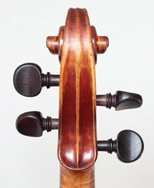 |
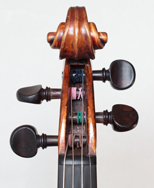 |
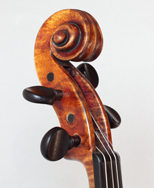 |
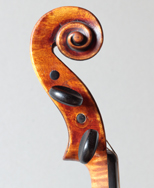 |
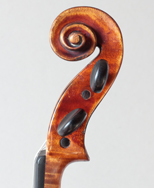 | ||||
| Was the upper peg broken off the pegbox? So little is left of the original head that the throat looks static, but despite its scars this scroll keeps swirling. | ||||||||
Bibliography
More about this Violin and Victor de Rivals:
- Archives of Gand, Bernardel, Caressa and Français, Museum of Music Archive Collections,
Cité de la Musique, Philharmonie de Paris:
- Sales Register for New and Old Instruments - Years 1840-1902, N° inv. E.981.8.38, page 95 (element 49 of 100),
- Inventory Register for New Instruments - Years 1854-1937, N° inv. E.981.8.8, page 21 (element 13 of 82),
- General Ledger - Years 1839-1854, N° inv. E.981.8.16, page 25 (element 15 of 199),
- General Ledger - Years 1866-1876, N° inv. E.981.8.14, page 868 (element 870 of 987),
- General Ledger - Years 1881-1887, N° inv. E.981.8.4, page 42 (element 24 of 978). - Société des Concerts du Conservatoire (1828-1967) on Hector.UCDavis.edu.
- The "Rivals-Mazères" Stradivari in the Cozio Archive on Tarisio.com.
- Archives of Gand, Bernardel, Caressa and Français on ArchivesMusee.CiteDeLaMusique.fr, Museum of Music Archive Collections, Cité de la Musique, Philharmonie de Paris.
- The Cozio Archive about Gand & Bernardel on Tarisio.com.

- Gand & Bernardel on VichyEncheres.WordPress.com,
Original in French,
Translation in English.

- Gand & Bernardel on Mimo-International.com.

- Gand & Bernardel on ViaductViolins.com.

- Gand & Bernardel on Luthiers-Mirecourt.com.

- Viola by Gand & Bernardel Frères, 1867, number 130,
on CollectionsDuMusee.PhilharmonieDeParis.fr.

- Violin by Gand & Bernardel Frères, 1875, number 589,
on TViolins.Tumblr.com, Thomas' S Violin Blog.

- Violin by Gand & Bernardel Frères, 1875, number 594,
on The-Saleroom.com.

- Violin by Gand & Bernardel Frères, 1879, number 846,
for Teresina Tua, on NetInsruments.com.

- "The Brompton's Book of Violin and Bow Makers" on Amati.com by John Dilworth, Ed. John Milnes, London, 2012, page 218.
- "A Dictionary of Violin Makers" on Archive.org by Cecie Stainer, Novello, London, 1896, pages 34-35.
- "Les Luthiers Français" by Loïc & Verena Le Canu, tome 1,
L & V Le Canu, Paris, 1993, pages 52-53.

- "Les Trésors de la Lutherie Française du XIXe" by Philippe Bodart,
Probomabo Éditeur, 1993, page 19.

- "Les Ancêtres du Violon et du Violoncelle" on Archive.org by Théodore Dubois, vol. 2, Charles Schmid Éditeur, Paris, 1901, pages 328-329.
- "Les Facteurs d'Instruments de Musique - Les Luthiers" on Archive.org by Constant Pierre, Edition Sagot, Paris, 1893, pages 256-262.
- "Universal Dictionary of Violin and Bow Makers" by William Henley, Amati Publishing Ltd, Tunbridge Wells, England, 1973, reprinted 1997, pages 114 & 435.
- "Encyclopedia of Violin-Makers" by Karel Jalovec, volume 1, Paul Hamlyn, London, 1968, pages 142 & 316.
- "Die Geigen- und Lautenmacher vom Mittelalter bis zur Gegenwart" on Archive.org by Willibald von Lütgendorff, volume 2, Frankfurter Verlags-Anstalt, Frankfurt am Main, Germany, third edition, 1922, page 157.
- "Liutai Antichi e Moderni" by Giovanni de Piccolellis, 1886, reprinted by Arnaldo Forni Editore, Bologna, Italy, 1985, page 173.
- "Dictionnaire Universel des Luthiers" by René Vannes, volume 1, Les Amis de la Musique, Brussels, 2nd edition, 1951, pages 28 & 121.
Measurements & Data
Maker: Eugène Gand (1825-1892), Ernest Bernardel (1826-1899), and Gustave Bernardel (1832-1904)
Made in: Paris, France
Year: 1870
Number: 535
Name: the "Rivals"
Made For: Victor de Rivals
Back Length: 359 mm *
Upper Bouts: 169 mm *
Middle Bouts: 110 mm *
Lower Bouts: 209 mm *
Stop Length: 196 mm
Rib Height at Neck: 30 mm *
Rib Height at Endpin: 31.5 mm *
Thickness of the Top: 3.3 mm
Thickness of the Back: 4.6 mm
F-hole Length: 76.0 mm *
Distance Between F-holes: 41.5 mm *
Distance Edge-Purfling: 4 mm
Scroll Width: 41 mm *
Weight: 411 grams
Label:
GAND & BERNARDEL Fres
Luthiers de la Musique de l'Empereur et du Conservatoire
N° 535. Paris 1870.
Label Translation:
GAND & BERNARDEL Brothers
Violin makers of the Emperor's Music and of the Conservatory
# 535. Paris 1870.
Condition: Multiple repaired fractures and cracks (including soundpost and bassbar) on belly, back, ribs and head. Scroll parts replaced. Grafted neck. Worn-away varnish.
* measured with a caliper
Maker: Eugène Gand (1825-1892), Ernest Bernardel (1826-1899), and Gustave Bernardel (1832-1904)
Made in: Paris, France
Year: 1870
Number: 535
Name: the "Rivals"
Made For: Victor de Rivals
Back Length: 359 mm *
Upper Bouts: 169 mm *
Middle Bouts: 110 mm *
Lower Bouts: 209 mm *
Stop Length: 196 mm
Rib Height at Neck: 30 mm *
Rib Height at Endpin: 31.5 mm *
Thickness of the Top: 3.3 mm
Thickness of the Back: 4.6 mm
F-hole Length: 76.0 mm *
Distance Between F-holes: 41.5 mm *
Distance Edge-Purfling: 4 mm
Scroll Width: 41 mm *
Weight: 411 grams
Label:
GAND & BERNARDEL Fres
Luthiers de la Musique de l'Empereur et du Conservatoire
N° 535. Paris 1870.
Label Translation:
GAND & BERNARDEL Brothers
Violin makers of the Emperor's Music and of the Conservatory
# 535. Paris 1870.
Condition: Multiple repaired fractures and cracks (including soundpost and bassbar) on belly, back, ribs and head. Scroll parts replaced. Grafted neck. Worn-away varnish.
* measured with a caliper

